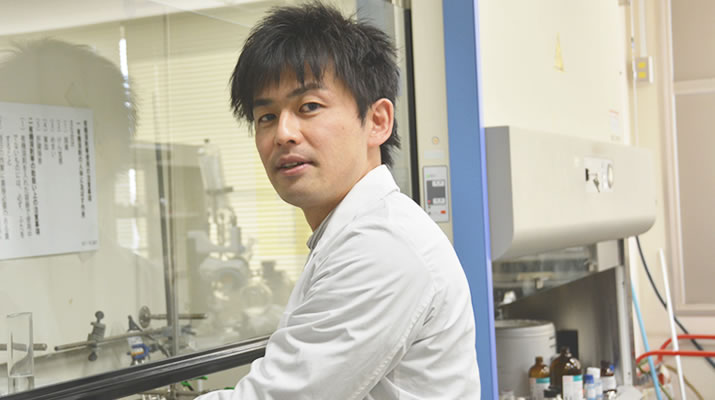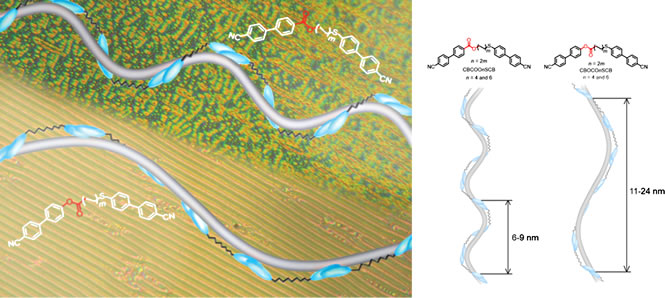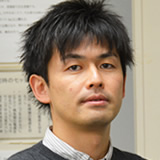
ここからコンテンツです。

Modulating helical nanostructures in a liquid crystal phase by molecular design
The ester bond direction in liquid crystal dimers impacts the helical pitch in the twist-bend nematic phase By Yuki Arakawa
A research team led by Assistant Professor Yuki Arakawa, from the Department of Applied Chemistry and Life Sciences at Toyohashi University of Technology, has successfully developed sulfur-containing liquid crystal (LC) dimer molecules1) with oppositely directed ester bonds, which exhibit a helical liquid crystal phase, viz. twist-bend nematic (NTB) phase2), over a wide temperature range, including at room temperature. Collaboration with a team at the Advanced Light Source research facility at Lawrence Berkeley National Laboratory, USA, revealed that the ester bond direction in the molecular structures largely impacts the pitch lengths of helical nanostructures in the NTB phase. It is expected that this molecular design can be used to tune the resultant physical properties of LC materials that would contribute to new LC technologies, such as LC laser, photo-alignment, and display technologies.
This research paper was selected in “Materials Advances HOT Article Collection, 2020”.
The NTB is a newly identified fluidic liquid crystal (LC) phase, which possesses a helical nanostructure with a pitch ranging from single to double digit nanometers, and which is attracting considerable interest in the LC science community. Recently, various approaches to applying the NTB materials to wavelength-tunable LC laser and photo-alignment technologies have been investigated. In terms of practicality, it is desirable for LC materials to form LC phases over a broad temperature range of 100°C or higher which encompasses room temperature. Unfortunately however, molecules that can maintain the NTB phase over a wide temperature range, including at room temperature, remain exceptionally rare. This has impeded deep evaluations of various properties and the development of new applications.
Assistant Professor Yuki Arakawa and his team from Toyohashi University of Technology have been taking an interest in developing novel sulfur-containing LC materials, especially for high-birefringence materials and twist-bend nematic LCs, based on thioether (R–S–R) linkages that contain sulfur. Sulfur, which is found naturally occuring in hot springs, is one of the few surplus resources in Japan. Sulfur or thioether bonds have high polarizability and are expected to be useful functional moieties for improving certain physical properties, such as refractive index and birefringence, compared with other bonds based on conventional atoms, such as methylene (carbon) and ether (oxygen).
Previously, Assistant Professor Yuki Arakawa and his team had successfully developed thioether-based bent molecules that exhibited the NTB phase. In this study, we attempted to devise new LC dimers by introducing oppositely directed ester bonds (i.e., –COO– and –OCO–) to the thioether-based bent dimeric molecules and elucidating the influence of the ester bond direction on the NTB phase behaviors. The team succeeded in developing new molecules that exhibit NTB phases over a wide temperature range, including room temperature.

Furthermore, the team observed a phenomenon, in which the helical pitches (6–9 nm) of the molecules with COO ester were approximately half (11–24 nm) of those with OCO ester. This is because the COO-ester dimers have more bent molecular geometries than the OCO-ester dimers, resulting in a more enhanced molecular precession in the helical structure for the former than for the latter. Finely tuning the molecular design (i.e., the ester bond direction) enables the manipulation of helical nanostructures, which is particularly important for optical applications.
According to Assistant Professor Arakawa, “LC molecules that exhibit the helical NTB phase over a broad temperature range, including room temperature, remain rare. No studies have clearly revealed the structure-property relationship between molecular design and the resultant helical structure, i.e. how the helical nano-structures can be controlled by molecular design. We believe that our studies provide insights into this question.”
This work was partly supported by the Japan Society for the Promotion of Science (JSPS) KAKENHI grant numbers 17K14493 and 20K15351, the Naito Research Grant, and research grants from the Toukai Foundation for Technology and Toyohashi University of Technology.
Technical Terms
- 1) A structure type of LC molecules in which two rigid structures are connected with a flexible alkyl chain spacer.
- 2) A helical liquid crystal phase in which bent molecules heliconically assemble to make a helical nano-structure.
Reference
Yuki Arakawa, Kenta Komatsu, Jun Feng, Chenhui Zhu, Hideto Tsuji. "Distinct twist-bend nematic phase behaviors associated with the ester-linkage direction of thioether-linked liquid crystal dimers." Materials Advances, 2020. https://doi.org/10.1039/D0MA00746C
ナノ周期長の異なるツイストベンドネマチック液晶材料の開発
By 荒川 優樹
豊橋技術科学大学 応用化学・生命工学系の研究チームは、ナノスケールのらせん構造を有するツイストベンドネマチック(NTB)相が室温まで冷却可能な二量体液晶分子を開発しました。米国のAdvanced Light Source (Lawrence Berkeley National Laboratory)との共同研究により、それら二量体分子構造中のエステル結合の向きが、NTB相のらせん構造の周期長に大きな影響を与えることを明らかにしました。このようなNTB液晶材料は、波長可変液晶レーザー、光配向材料などへの応用が期待されます。
本研究論文は、「Materials Advances HOT Article Collection, 2020」に選出されました。
NTB相は近年発見された新しい液晶相の一つであり、数ナノメートルから数十ナノメートルピッチのらせん構造を有することが特徴です。最近、NTB液晶材料を波長可変液晶レーザーや光配向技術に応用するための様々なアプローチが検討されております。実用性の観点から、液晶材料は室温を含む100℃以上の広い温度範囲で液晶相を形成することが望まれます。一方で、NTB相を室温でも保持できる液晶分子の報告例は極めて稀です。
研究チームは、硫黄を有するチオエーテル(R–S–R)結合を導入した液晶材料の開発に取り組んでいます。必須元素であり、温泉の成分としても知られる硫黄は、機能性有機材料における汎用元素である炭素や酸素などと比較して、屈折率や複屈折などの物理的特性を改善するために有用な元素です。一方で研究チームは以前に、NTB相を形成するための分子構造にもチオエーテル結合が有効であることを明らかにしました。
本研究では、チオエーテル系の二量体液晶分子をベースとし、向きの異なるエステル結合(COOおよびOCO)をそれぞれ導入した新しい類縁体を開発し、それら類縁体が室温を含む広い温度範囲でNTB相を示すことを明らかにしました。共鳴X線散乱を用いたらせんピッチの評価により、COOエステル二量体とOCOエステル二量体のらせんピッチはそれぞれ6~9 nmおよび11~24 nmであることがわかり、エステル結合の向きの違いによりらせん構造の周期長が約2倍異なることが明らかとなりました。このように、Å単位の分子設計で、ナノスケールの高次構造の制御が可能になります。
研究チームのリーダーである荒川助教は、「室温を含む広い温度範囲でらせん状のNTB相を示すLC分子は、まだ珍しい。また、分子設計とその結果としてのらせん構造との構造-物性関係、すなわち、らせん状のナノ構造を分子設計でどのように制御できるかを明確に明らかにした研究はありません。今回の研究は、そのヒントになると信じています。」と語っています。
Researcher Profile

| Name | Yuki Arakawa |
|---|---|
| Affiliation | Department of Applied Chemistry and Life Science |
| Title | Assistant Professor |
| Fields of Research | Liquid crystals, Polymer chemistry, Organic sulfur chemistry, High birefringence materials, Optical materials |
| Degree | Ph. D. (Engineering), Tokyo Institute of Technology |
ここでコンテンツ終わりです。
